Figure 5.—
pr1 aleurones produce pelargonidin, while Pr1 aleurones produce cyanidin. (A) TLC of extracts from Pr1 or pr1 kernels. Samples shown in each lane are: 1, control C1 for cyanidin; 2, control C2 for pelargonidin; 3–5, Pr1; and 6–8, pr1. (B) HPLC analysis of silk methanolic extracts from sibling plants carrying pr1 or Pr1. Extracts were analyzed at wavelength 230 nm for DHK and DHQ. pr1 shows single peak representing DHK, while Pr1 has two peaks representing both compounds; thus DHK is converted into DHQ through the action of F3′H (Figure 1).

